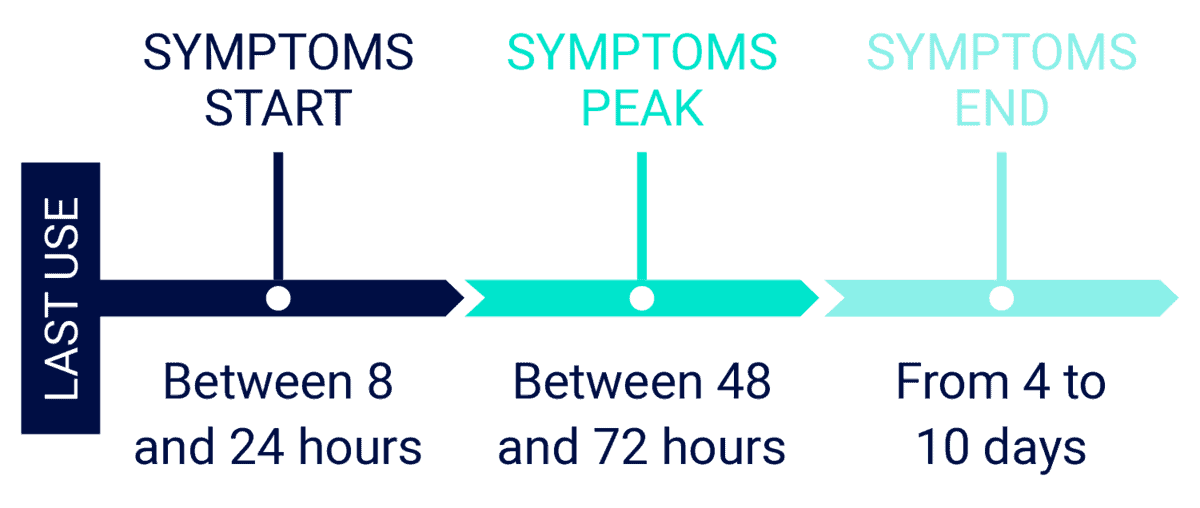When someone with opioid addiction tries to quit, they often experience harsh withdrawal symptoms. Usually, these withdrawals cause so much pain that people resume using opioids to ease the symptoms. For most people, it is impossible to stop abusing opioids without the help of an addiction doctor.
In This Article
How Long Do Withdrawals Last?
While withdrawal symptoms are very unpleasant and painful, they usually begin to improve within seventy-two hours.
Within a week, there should be a significant decrease in the acute symptoms.
Longer-term symptoms are usually more behavioral and emotional, though there can be mild physical symptoms (such as withdrawal insomnia) that may take several weeks to resolve.
Opioid Withdrawal Timeline
Generally:
- Symptoms start sometime between 8 and 24 hours after you last use the drugs.
- You feel worst between 48 and 72 hours (2-3 days) after your last use.
- Symptoms stop sometime between 4 to 10 days after you last used.
How Long Opioiod Withdrawal Lasts 
As you might suspect, timing depends on the individual and factors such as:
- Length of time using the substance
- The substance itself (ie. the new drug ISO detox vs. heroin detox vs. prescription painkiller detox like oxycodone or hydrocodone)
- Method of abuse (ie. snorting, smoking, injecting, or swallowing)
- Amount taken each time
- Family history of addiction and genetic makeup
- Medical and mental health history
Withdrawal Symptoms Lasting Longer Than 10 Days
Some people experience lingering symptoms like fatigue or inexplicable chronic pain. The term post-acute withdrawal symptoms (PAWS) is used to describe withdrawal symptoms that last longer than 10 days. Learn more about post-acute withdrawal syndrome.
What Are the Symptoms of Opioid Withdrawal?
Generally, physical opioid withdrawal symptoms can be mild to severe and can last anywhere from a few days to a month. It comes in two phases.
Initial Phase Withdrawal Symptoms
Most people start to feel these symptoms after not using opioids for around eight hours.
- Muscle aches
- Excessive sweating
- Lethargy and excessive yawning
- Runny nose
- Anxiety
- Extreme cravings and thoughts of using
- Restlessness
- Agitation
- Insomnia
- Restless leg syndrome
Second Phase Withdrawal Symptoms
The second phase, which can be more intense, begins after the first day or so. Symptoms in the second phase include:
- Dilated pupils
- Rapid heartbeat
- Diarrhea, nausea and vomiting
- Chills and goosebumps
- Abdominal cramps
- High blood pressure
What Happens During Withdrawal?
The body produces natural opioids that control pain, anxiety and depression. But, if a person gets a broken leg, for example, the body doesn’t produce enough opioids to treat the pain. External opioids treat the pain.
Over time and prolonged use, opioid receptors in the brain, the spinal cord and gastrointestinal tracts become desensitized. Higher dosages are needed to achieve the same effect. The increased consumption creates a dependency on the receptors, and when the person stops taking the opioid, the body can't cope with the lack of the drug.
How can I feel better?
There's no need to feel so terrible. Suboxone clinics use buprenorphine to feel better right away and get through withdrawal while you live at home. Though there are more side effects of methadone, it is also an option that provides immediate relief.
Without medical supervision, withdrawals are uncomfortable, stressful and too often result in overdose. The physical and mental toll caused by opioid withdrawal can be addressed.
Symetria Opiate Detox Centers
Illinois Opioid Detox Clinics
- Opioid Detox in Chicago
- Opioid Detox in Naperville
- Opioid Detox in Joliet
- Opioid Detox in Des Plaines
- Opioid Detox in Palos Heights
- Opioid Detox in Vernon Hills
Texas Opioid Detox Clinics
- Opioid Detox in Houston
- Opioid Detox in Spring
- Opioid Detox in College Station
- Opioid Detox in Fort Worth
- Opioid Detox in Hurst
- Opioid Detox in Lewisville
- Opioid Detox in Arlington
If you've tried to stop, it's easy to feel like there is no hope of overcoming opioid addiction, but thousands of people are living healthily and happily without feeling high or sick. If you've been able to get past the detox phase, joining an IOP program or using medications like Suboxone or methadone helps you stay healthy long-term.

